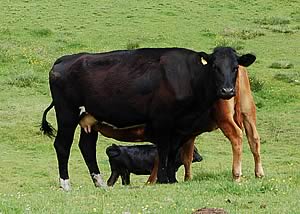 |
|||||||||
|
|||||||||||||||||||
|
|
Better Pneumonia Control from Switch in
Wormer Timing Worming suckler beef calves up to five-weeks before housing with a long acting treatment can produce enough extra live-weight gain off autumn grass to cover the costs of that treatment and two others earlier in the year. It could also help reduce pneumonia especially during the early housing period, according to SAC beef adviser Dr Basil Lowman [1].
This strategy works because the active ingredient (A/I) doramectin, available in Dectomax™, continues to prevent new infestations for five weeks after treatment. By getting cattle worm-free for five pre-housing weeks, Dr Basil Lowman estimates that growth rates could be boosted by up to 0.15kg per head per day. As a result by the end of that period, cattle could have gained an additional 5.25kg in body weight (35 days x 0.15kg/day = 5.25kg). At £1/kg, this £5.25-worth of extra weight per animal could be worth more than the combined cost of using doramectin-based wormer at turnout and eight weeks later (ie following the 0-8 programme), then again pre-housing, according to Pfizer’s senior livestock vet Carolyn Hogan [2]. “Bearing in mind that the vast majority of producers use a wormer at housing as a matter of course, this strategy does not require any additional treatment, just a switch in timing,” she says. “Dosage being related to bodyweight, then earlier dosing also means the quantity of wormer used, and therefore treatment cost, is lower.” According to Dr Lowman, the most compelling reason for following this plan is a reduced pneumonia risk at housing. “If I had a wish to get rid of one thing from livestock production, it would be pneumonia,” he says. “It is the biggest cause of financial loss, not to mention a major welfare problem, in beef production. If it causes just one fatality, then many more animals on the same unit will also be affected, will never recover fully, and will lose money. “In addition to killing stomach and gutworms, a five-weeks pre-housing dose of long-acting wormer will also kill lungworm. Crucially, this timing will also allow enough time for dead worms to be coughed up and for lung damage to repair while cattle are still outside and under no stress. “By the time of housing, this gives them the best chance of being fully recovered and as ready as possible for the stresses of housing.” Dr Lowman warns that, while animals may look physically fit, a surprising proportion will be carrying some lungworm burden at this time of the year. “It really is worth making the effort to treat them in advance of housing,” he urges. If cattle are also going to be vaccinated against pneumonia at that time of year – with Rispoval® 4, for example – then the first of two doses can be given at the same time as worming, adds Carolyn Hogan. On a practical note, producers have asked what should happen if a mild and dry autumn allows cattle to be left at grass for longer than the wormer’s five week duration of activity. Bearing in mind that the resulting higher growth rates may already have repaid the whole grazing season’s wormer costs, Ms Hogan advises an additional wormer treatment at housing. With pneumonia prevention in mind, Dr Lowman recommends a four-step plan:
For farms where a pre-housing dose is not practicable, Carolyn Hogan says the next best thing remains Dectomax treatment at housing for a worm-free and lice-free winter. The doramectin-based wormer offers a lice-free guarantee. IMPORTANT CAUTION: Farmers are advised that this strategy requires a sufficient duration of action from the wormer used. The persistent effect of the A/I doramectin means it is the only wormer which can be given up to five weeks pre-housing and comes with a lice free guarantee over winter. Therefore this strategy should not be adopted with any other wormer for internal and external parasite control at housing. [1] 9th August 2007. Dr Basil Lowman. Speaking at a press briefing,
The Farmers Club, London.
|
||||||||||||||||||

|
|
||||||||||||||||||
| home | agri-services | pedigree
pen | news | dairy | beef | machinery property | organisations | site map |
|||||||||||||||||||

